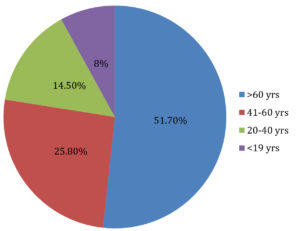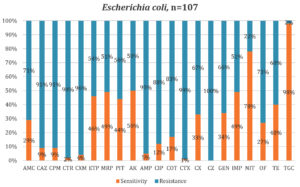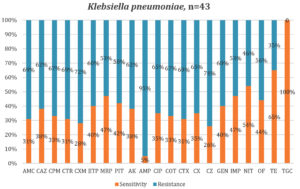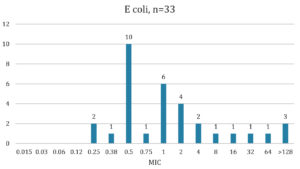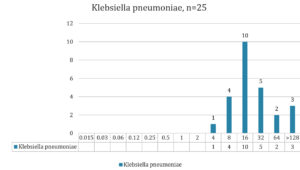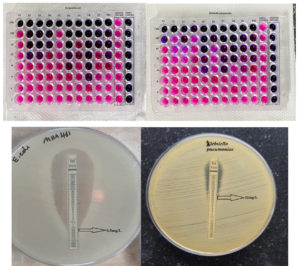ISSN: 0973-7510
E-ISSN: 2581-690X
UTI is one of the most common infections requiring antibiotic treatment and hospitalization. The rising trend in multidrug resistance to commonly used antibiotics has reduced the therapeutic options for treating these infections. Reexploring older antibiotics like nitrofurantoin and fosfomycin provide treatment options and help combat resistance. This prospective study was conducted in the Department of Microbiology, SRM Medical College Hospital and Research Center, from July 2021 to February 2022. The study included only clean catch midstream urine isolates of Escherichia coli and Klebsiella pneumonia from hospitalized patients and outpatients. Standard microbiological procedures were used to process the urine samples. Direct gram stain and conventional biochemical reactions were performed to identify the isolates. The antimicrobial susceptibility testing was carried out by the Kirby Bauer disk diffusion method and Minimum Inhibitory Concentration by E- test gradient method for fosfomycin. MIC for nitrofurantoin was determined by Micro Broth Well Dilution according to CLSI guidelines 2021. Among 150 urine samples, Escherichia coli 107 (71.3%) was higher than Klebsiella pneumonia 43 (29%). Carbapenemase production was seen in 58 (63.04%) isolates by the Kirby Bauer disc diffusion method. Among the 58 positive carbapenemase producers, E. coli was found to be 33 (56.8%), and Klebsiella pneumonia was 25 (43.1%). Fosfomycin susceptibility rates by E test were reported to be high in Escherichia coli, ranging from 0.5-1mg/L. Klebsiella pneumonia was less susceptible to fosfomycin ranging from 16-32mg/L. Only 7(21%) isolates of Escherichia coli showed MIC of 1-4µg/ml to nitrofurantoin by broth microdilution. 21 (63.63%) isolates of Escherichia coli and 11(44%) isolates of Klebsiella pneumonia were reported to have an intermediate category with MIC of 8-32µg/mL. A higher MIC of 64- > 256µg/ml was shown by 5 (15.15%) isolates of Escherichia coli and 14 (56%) isolates of Klebsiella pneumonia. Older medications may resurface as useful therapeutic choices as resistance to current treatment options grow.
UTI, Carbapenem Resistance, MIC Nitrofurantoin, Fosfomycin, Enterobacteriaceae
UTI is the most common bacterial illness affecting 150 million people globally each year.1 In 2007, there were an estimated 10.5 million hospital visits for UTI symptoms (representing 0.9% of all ambulatory visits) and 2-3 million emergency room visits in the United States. Urolithiasis varies by region, with a prevalence of 7.00 per cent and 5.06 per cent in Australia and Spain by 2007, 8.80 per cent in America in 2010, and 6.50 per cent in China in 2015. Urolithiasis has been much more common in the last half-century, with an estimated yearly cost burden of $5.30 billion in 2014.2 In the United States, an estimated 250,000 instances of pyelonephritis occur each year, with females having a greater incidence. The estimated incidence of pyelonephritis in women aged 18 to 49 is 28 per 10,000, with 7% of cases requiring hospitalization. Cultural and genetic factors may influence prevalence (for example, pyelonephritis affects 59 out of 10,000 people in South Korea).3 Even though urinary tract infections are the third most frequent infection in India, only a few studies have been published from West Bengal, Aligarh and Odisha on clean catch midstream urine to determine the antibiotic susceptibility and resistance pattern of the uropathogens.4-6
The prevalence rate of CRE is recorded differently in different parts of India. Gram-negative bacilli Escherichia coli is liable for causing the majority of UTIs, but other organisms of importance include Klebsiella pneumonia, Proteus spp, Acinetobacter spp, Enterococcus spp, Pseudomonas aeruginosa and Serratia spp.2
UTIs due to multidrug-resistant bacteria are becoming more common, related to antibiotic use.7 The rise in resistance among Enterobacteriaceae has made empiric regimen selection difficult, especially in multidrug-resistant infections. Extended-spectrum beta-lactamases (ESBL)-mediated resistance among Enterobacteriaceae has been reported worldwide in the last decade, including in Chicago. Other resistance mechanisms among urinary infections have also been discovered.8
Carbapenemase enzymes are the leading cause of carbapenem resistance. Enterobacteriaceae‘s most prevalent carbapenemases are divided into Ambler classes A, B, and D. The Klebsiella pneumoniae carbapenemases (KPC) and Imipenem-hydrolysing-lactamase (IMI) are the most common in class A, with KPC being the most common overall. Metallo-lactamases (MBL), New Delhi Metallo-lactamases (NDM), Imipenem-resistant Pseudomonas enzyme (IMP), and Verona integron-mediated Metallo-lactamase are all members of Class B. (VIM). Finally, Oxacillin-hydrolyzing carbapenemases (OXA) are found in class D, with OXA-48 being the most usually isolated. Carbapenemase genes can be acquired or intrinsic.9
Treatment is complicated since carbapenemases are resistant to many antibiotics. With only a few antibiotics expected to be in the pipeline in the next five to ten years, we are left with reintroducing old drugs like nitrofurantoin and fosfomycin to help treat UTIs.10 Fosfomycin inhibits the cell wall synthesis of both gram-negative and gram-positive and acts as a potential alternative for treating uncomplicated UTIs.11 There is also evidence that fosfomycin exhibits sufficient activity against pathogens causing infections in the critical care unit.12 Nitrofurantoin interferes with bacterial ribosomal proteins and inhibits protein synthesis. The resistance to nitrofurantoin is uncommon, and many MDR organisms are susceptible.13
This prospective study was conducted in the Department of Microbiology, SRM Medical College Hospital and Research Center, from July 2021 to February 2022. The Ethical clearance was approved by the Institutional Ethics Committee of SRM. The study included only clean catch midstream urine isolates of Escherichia coli and Klebsiella pneumonia from hospitalized patients and outpatients. The study’s results will aid in determining the prevalence of carbapenem-resistant organisms and improve patient care by using older drugs such as Nitrofurantoin and Fosfomycin in treating urinary tract infections. Standard microbiological procedures were used to process the urine samples. Urine samples were streaked on UTI Chrom agar and Blood agar and incubated for 18-24 hours at 37°C after a direct gram stain. Conventional biochemical reactions were performed to identify the isolates. The antimicrobial susceptibility testing was carried out by the Kirby Bauer disk diffusion method. Minimum Inhibitory Concentration was determined by E- the test gradient method and Micro Broth Well Dilution according to CLSI guidelines 2021.
Data was taken regarding the patient’s age and gender, urine culture characteristics, organism isolation, and antibiotic susceptibility profile by the Kirby Bauer disk diffusion method according to CLSI guidelines 2021. Antibiotics screened were Amoxicillin clav (20µg), Ceftazidime (30µg), Cefipime (30µg), Ceftriaxone (30µg), Cefuroxime (10µg), Ertapenem (10µg), Meropenem (10µg), Piperacillin Tazobacten (100µg/10µg), Amikacin (30µg), Ampicillin (10µg), Ciprofloxacin (5µg), Cotrimoxazole (1.25µg), Cefotaxime (30µg), Cefoxitin (30µg), Cefazolin (30µg), Gentamycin (10µg) Imipenem (10µg), Nitrofurantoin (300µg) Ofloxacin (5µg), Tetracycline (300µg), Tigecyclin (15µg). The susceptibility patterns of CRE Escherichia coli and Klebsiella pneumonia were analyzed and entered in the MS excel sheets. Fosfomycin (Ezy MIC strips Hi-media) susceptibility rates were determined with the E test gradient method, and the Minimum inhibitory concentration of Nitrofurantoin (Sigma Aldrich Chemical Pvt.Ltd.) for CRE Escherichia coli and Klebsiella Pneumoniae were determined by Broth microdilution method as per CLSI guidelines 2021.14 The interpretation of MIC for broth microdilution was determined using a Resazurin dye (Sisco Research Laboratories Pvt.Ltd.).
E-Test Gradient Method
After incubation, the test bacterium was inoculated into Muller Hinton Agar supplemented with 25 μg/ml of glucose-6- phosphate. Antibiotic strips impregnated with an increasing concentration gradient of fosfomycin are laid on the agar surface and incubated for 24 hours at 37°C.15
According to CLSI guidelines 2021, the MIC breakpoints categories for the Enterobacteriaceae are:
S |
I |
R |
|
Fosfomycin |
<64 |
128 |
>256 |
Broth Micro dilution
The commercially available antimicrobial powder was dissolved within the diluent (phosphate buffer), and a standard inoculum was prepared using the direct colony suspension method from a 24 hours cultured agar plate. Muller Hinton Broth is added to each of the micro titre plate’s wells, 25L of nitrofurantoin dilution 256g/ml to column 1, 128g/ml to column 2, and so on until column 10 of the plate has 0.5g/ml is added. Column 11 is a growth control that only contains media and bacterial inoculum, while column 12 is a media control that contains medium 100L. Incubate the plates at 37°C for 24 hours in an ambient air incubator within 15 minutes of adding inoculum.15
According to CLSI guidelines 2021, the MIC breakpoints for Enterobacteriaceae are:
S |
I |
R |
|
Nitrofurantoin |
<32 |
64 |
>128 |
Preparation of Resazurin Dye
0.015g of Resazurin powder (Sisco Research Laboratories Pvt.Ltd.) is diluted in 100 ml distilled water. After incubation for 24 h at 37°C, resazurin (0.015 %) was added to all wells (30 µl per well) and further incubated for 2–4 h for the observation of colour change. The colour changes from blue to pink if the organism grows.16
The study conducted in the Department of Microbiology, SRM Medical College Hospital & Research Centre between July 2021 and February 2022 included 150 urine samples containing both Escherichia coli and Klebsiella pneumonia. Escherichia coli 107 (71.3%) were found to be high than Klebsiella pneumonia 43 (29%) among the 150 samples collected for urine culture. The study found that people aged 61 years and over (51.7%) had the highest CRE, followed by those aged 41-60 years (25.8% ), (14.5.%) in 20-40 yrs of age and only 8 % in < 19 years old Figure 1. Carbapenemase production was seen in 58 (63.04%) isolates from the urine samples collected by Kirby Bauer disc diffusion methods. Among the 58 positive carbapenemase producers, E. coli was found to be 33 (56.8%), and Klebsiella pneumonia was 25 (43.1%). The routine antibiotic susceptibility and resistant pattern of carbapenem-resistant Escherichia coli and Klebsiella pneumonia by the Kirby Bauer disk diffusion method are shown in Figures 2 and 3.
Figure 2. Antibiotic susceptibility and resistant pattern of CR Escherichia coli by Kirby Bauer disk diffusion method
Figure 3. Antibiotic susceptibility and resistant pattern of CR Klebsiella pneumoniae by Kirby Bauer disk diffusion method
The MICs of Fosfomycin by E test method for Escherichia coli and Klebsiella Pneumoniae is shown in Figure 4, 5 and 6. The rates of Fosfomycin susceptibility were reported to be high in Escherichia coli, ranging from 0.5 to 1mg/L. Klebsiella pneumonia was less susceptible to fosfomycin ranging from 16-32mg/L. MIC for nitrofurantoin by broth microdilution method- carbapenem-resistant Escherichia coli and Klebsiella pneumonia demonstrated that only 7(21%) isolates of Escherichia coli showed MIC of 1-4µg/ml. 21 (63.63%) isolates of Escherichia coli and 11(44%) isolates of Klebsiella pneumonia were reported to have an intermediate category with MIC of 8-32µg/ml. A higher MIC of 64- > 256µg/mL was shown by 5 (15.15%) isolates of Escherichia coli and 14 (56%) isolates of Klebsiella pneumonia, as summarised in Table.
Figure 6. MIC of Nitrofurantoin for Escherichia coli and Klebsiella pneumonia by Broth Microdilution and E test
Table :
Minimum Inhibitory Concentration of Nitrofurantoin for CR Escherichia coli & Klebsiella pneumoniae by Broth microdilution method.
| Organism | MIC of Nitrofurantoin (1- >256) | ||||||||
|---|---|---|---|---|---|---|---|---|---|
| >256 μg/mL | 128 μg/mL | 64 μg/mL | 32 μg/mL | 16 μg/mL | 8 μg/mL | 4 μg/mL | 2 μg/mL | 1 μg/mL | |
| Escherichia coli | 4 | – | 1 | 4 | 11 | 6 | 7 | – | – |
| Klebsiella pneumoniae | 8 | 6 | – | 5 | 6 | – | – | – | – |
A total of 150 samples were recruited for the study. Of these, 58 were positive for Carbapenemase production, giving a prevalence of 38%. In the present study, the prevalence of CRE in UTI in the hospital was relatively high. Wattal et al. conducted a similar study, which reported a high CRE prevalence rate ranging from 13 to 51% in tertiary care hospitals in Delhi.17
Multidrug-resistant Escherichia coli and Klebsiella pneumonia strains are rising, contributing to higher morbidity and mortality. All isolates were resistant to multiple antibiotics. Out of 150 urine samples, 58 were carbapenem-resistant, and Escherichia coli was more frequently isolated 33 (56.8%) than Klebsiella pneumonia 25 (43.1%)
The study found that people aged 61 years and over (51.7%) had the highest CRE, followed by those aged 41-60 years (25.8%); a similar finding was observed by Herdiyanti et al.18 Probably because these age groups are most exposed to antibiotics, they have higher co-morbidities such as hypertension, type 2 diabetes mellitus, COPD, and other conditions for which they are more frequently hospitalized than the general population.
The highest prevalence of carbapenem resistance in the present study was observed in E. coli (56.8%), which correlates with Sanjeev K et al.(Udaipur),19 and Parimala et al. (63%).20 The predominance of Escherichia coli might be due to urine samples and Escherichia coli being a major urinary pathogen. In contrast, the study conducted by Wattal et al. on urinary samples.16 displays a predominance of Klebsiella pneumonia.
Carbapenem-resistant Escherichia coli had the highest sensitivity to tigecycline (96.9%) and nitrofurantoin (90%) which correlates with the findings of Chauhan et al. Meerut (tigecycline 98%)21 and Dusi Ratna Harika et al. (nitrofurantoin 88.4%),22 whereas, Klebsiella pneumonia showed maximum sensitivity to tigecycline (100%) and tetracycline (48%) followed by nitrofurantoin (24%). Other studies conducted by Chauhan et al.21 reported the least susceptibility to meropenem and imipenem, which correlates to our present study.
E.coli was highly resistant to Cephalosporins (first & second) generation (100%), ciprofloxacin and cotrimoxazole, followed by amikacin (24%). The overall resistance to meropenem in this study was found to be (6%) in contrast to the study by Behewa et al.23 who reported 19.50% meropenem resistance. However, Klebsiella pneumoniae was highly resistant to ceftazidime, cefepime, ceftriaxone, cefuroxime, ertapenem, piperacillin-tazobactam, amikacin, ampicillin, ciprofloxacin, cefotaxime, cefazolin and gentamicin (100%).
The MICs of fosfomycin were far lower for E.coli than for Klebsiella pneumonia. The mode MIC for E. coli was 0.5 mg/L compared with 16 mg/L for Klebsiella pneumonia. Susceptibility to fosfomycin was high in E.coli (90.9%), followed by Klebsiella pneumonia (80%) which had a MIC < 32mg/L, which correlates with the study of Wouter van den Bijllaardt et al. 24
Micro broth dilution was performed for nitrofurantoin to obtain the MIC values. MIC ranged from 4-32mg/L for E. Coli strains to 16-32mg/L for Klebsiella pneumoniae strains, which correlates to a study by Fiona Fransen et al.25 and Karolina Klesiewicz et al.26 A higher MIC of 64- > 256µg/mL was shown by 5 (15.15%) isolates of Escherichia coli and 14 (56%) isolates of Klebsiella pneumonia. In this study, the susceptibility rate of Escherichia coli isolates for nitrofurantoin was 84% in comparison to Klebsiella pneumonia which was only around 44% sensitive, correlating with the findings of Neeraj K.Tulara.27
There is a scarcity of antibiotics for therapy in the face of developing multidrug resistance. Antibiotics like nitrofurantoin and fosfomycin, which are no longer commonly recommended, can treat infections like UTIs. However, regular monitoring is essential to detect trends in resistance to these antibiotics.
ACKNOWLEDGMENTS
None.
CONFLICT OF INTEREST
The authors declare that there is no conflict of interest.
AUTHORS’ CONTRIBUTION
All authors listed have made a substantial, direct and intellectual contribution to the work, and approved it for publication.
FUNDING
None.
DATA AVAILABILITY
The datasets generated and/or analysed during the current study are available from the corresponding author on reasonable request.
ETHICS STATEMENT
This study was approved by the Institutional Ethics Committee of SRM Medical College Hospital & Research Centre, Chennai, Tamil Nadu, India, with reference number 2890/IEC/2021.
INFORMED CONSENT
Written informed consent was obtained from the participants before enrolling in the study.
- Ahmed MA, Shukla GS, Bajaj HK. Incidence of Urinary Tract Infections and determination of their susceptibility to antibiotics among Pregnant Women. International Journal of Cell Science and Biotechnology 2016;5:12-16.
- Flores-Mireles AL, Walker JN, Caparon M, Hultgren SJ. Urinary tract infections: epidemiology, mechanisms of infection and treatment options. Nat Rev Microbiol. 2015;13(5):269-284.
Crossref - Medina M, Castillo-Pino E. An introduction to the epidemiology and burden of urinary tract infections. Ther Adv Urol. 2019;11:1756287219832172.
Crossref - Saha S, Nayak S, Bhattacharyya I, et al. Understanding the patterns of antibiotic susceptibility of bacteria causing urinary tract infection in West Bengal, India. Front Microbiol. 2014;5:463.
Crossref - Akram M, Shahid M, Khan AU. Etiology and antibiotic resistance patterns of community-acquired urinary tract infections in JNMC Hospital Aligarh, India. Ann Clin Microbiol Antimicrob. 2007;6:4.
Crossref - Dash M, Padhi S, Mohanty I, Panda P, Parida B. Antimicrobial resistance in pathogens causing urinary tract infections in a rural community of Odisha, India. J Family Community Med.2013;20(1):20-26.
Crossref - Mutters NT, Mampel A, Kropidlowski R, et al. Treating urinary tract infections due to MDR E. coli with Isothiocyanates-a phytotherapeutic alternative to antibiotics?. Fitoterapia. 2018;129:237-240.
Crossref - Khawcharoenporn T, Vasoo S, Singh K. Urinary tract infections due to multidrug-resistant Enterobacteriaceae: prevalence and risk factors in a Chicago Emergency Department. Emerg Med Int. 2013;2013:258517.
Crossref - Al Mana H, Sundararaju S, Tsui CK, et al. Whole-genome sequencing for molecular characterization of carbapenem-resistant Enterobacteriaceae causing lower urinary tract infection among pediatric patients. Antibiotics. 2021;10(8):972.
Crossref - Amladi AU, Abirami B, Devi SM, et al. Susceptibility profile, resistance mechanisms & efficacy ratios of fosfomycin, nitrofurantoin & colistin for carbapenem-resistant Enterobacteriaceae causing urinary tract infections. Indian J Med Res. 2019;149(2):185-191.
Crossref - Gardiner BJ, Stewardson AJ, Abbott IJ, Peleg AY. Nitrofurantoin and fosfomycin for resistant urinary tract infections: old drugs for emerging problems. Aust Prescr. 2019;42(1):14-19.
Crossref - Sahni RD, Balaji V, Varghese R, John J, Tansarli GS, Falagas ME. Evaluation of fosfomycin activity against uropathogens in a fosfomycin-naive population in South India: a prospective study. Fut Microbiol. 2013;8(5):675-680.
Crossref - Squadrito FJ, del Portal D. Nitrofurantoin. Stat Pearls. 2021.
- CLSI supplement M100. Wayne, PA: Clinical and Laboratory Standards Institute; 2021.
- Lalitha MK. Manual on antimicrobial susceptibility testing. Performance standards for antimicrobial testing: Twelfth Informational Supplement. 2004;56238:454-456.
- Kowalska-Krochmal B, Dudek-Wicher R. The Minimum Inhibitory Concentration of Antibiotics: Methods, Interpretation, Clinical Relevance. Pathogens. 2021;10(2):165.
Crossref - Wattal C, Goel N, Oberoi JK, Raveendran R, Datta S, Prasad KJ. Surveillance of multidrug resistant organisms in tertiary care hospital in Delhi, India. J Assoc Physicians India. 2010;58(Suppl):32-36.
- Herdiyanti H, Alimsardjono L, Indiastuti DN. Resistance Patterns of Escherichia coli and Klebsiella pneumoniae Bacteria Against Amikacin, Ceftazidime, Meropenem, Nitrofurantoin Antibiotics in Elderly Patients with UTI in RSUD Dr. Soetomo. JUXTA: Jurnal Ilmiah Mahasiswa Kedokteran Universitas Airlangga. 2019;10(1):20-24.
Crossref - Kumar S, Mehra SK. Performance of modified Hodge test and combined disc test for detection of carbapenemases in clinical isolates of Enterobacteriaceae. Int J Curr Microbiol Appl Sci. 2015;4(5):255-261
- Parimala TV. Screening of carbapenem resistant Enterobacteriaceae among nosocomial isolates: A study from South India. Int J Curr Microbiol App Sci. 2017;6(4):460-465.
Crossref - Chauhan K, Pandey A, Asthana AK, Madan M. Evaluation of phenotypic tests for detection of Klebsiella pneumoniae carbapenemase and metallo-beta-lactamase in clinical isolates of Escherichia coli and Klebsiella species. Indian J Pathol Microbiol. 2015;58(1):31.
Crossref - Sirisha DT. Nitrofurantoin as an option in the treatment of Extended Spectrum BetaLactamase Producing Escherichia Coli and Klebsiella Pneumoniae in Uncomplicated UTI. Journal of Medical Science and Clinical Research. 2019;7(6).
- Mahapatra A, Nikitha K, Rath S, Behera B, Gupta K. Evaluation of HiCrome KPC Agar for the Screening of Carbapenem-Resistant Enterobacteriaceae Colonization in the ICU Setting of a Tertiary Care Hospital. J Lab Physicians. 2021;13(04):358-361.
Crossref - van den Bijllaardt W, Schijffelen MJ, Bosboom RW, et al. Susceptibility of ESBL Escherichia coli and Klebsiella pneumoniae to fosfomycin in the Netherlands and comparison of several testing methods including Etest, MIC test strip, Vitek2, Phoenix and disc diffusion. J Antimicrob Chemother. 2018;73(9):2380-2387.
Crossref - Fransen F, Melchers MJ, Meletiadis J, Mouton JW. Pharmacodynamics and differential activity of nitrofurantoin against ESBL-positive pathogens involved in urinary tract infections. J Antimicrob Chemother. 2016;71(10):2883-2889.
Crossref - Klesiewicz K, Karczewska E, Nowak P, et al. Comparative in vitro studies of furazidin and nitrofurantoin activities against common uropathogens including multidrug-resistant strains of E. coli and S. aureus. Acta Poloniae Pharmaceutica-Drug Research. 2018;75(3).
- Tulara NK. Nitrofurantoin and fosfomycin for extended spectrum beta-lactamases producing Escherichia coli and Klebsiella pneumoniae. J Glob Infect Dis. 2018;10(1):19-21.
Crossref
© The Author(s) 2023. Open Access. This article is distributed under the terms of the Creative Commons Attribution 4.0 International License which permits unrestricted use, sharing, distribution, and reproduction in any medium, provided you give appropriate credit to the original author(s) and the source, provide a link to the Creative Commons license, and indicate if changes were made.



